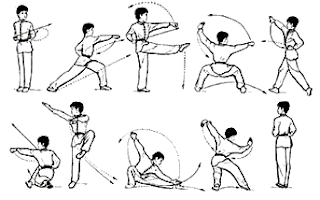 Changquan (Traditional Chinese: 長拳; Simplified Chinese: 长拳; literally “Long Fist”) is a general term for external (as opposed to internal) Northern Wushu. It is one of the types of Wushu kung fu.
Changquan (Traditional Chinese: 長拳; Simplified Chinese: 长拳; literally “Long Fist”) is a general term for external (as opposed to internal) Northern Wushu. It is one of the types of Wushu kung fu.The forms within the Long Fist style emphasize fully extended kicks and striking techniques, and by its appearance would be considered a long range fighting system. In some Long Fist styles the motto is that “the best defense is a strong offense,” in which case the practitioner launches a pre-emptive attack so aggressive that the opponent doesn’t have the opportunity to attack.
Long Fist uses large, extended, circular movements to improve overall body mobility in the muscles, tendons, and joints. After advanced study, a Long Fist practitioner will find that its forms contain Qin Na joint-locking techniques, as well as Shuai Jiao throws and takedowns.
The Long Fist style is considered to contain a good balance of hand and foot techniques, but in particular it is renowned for its devastating acrobatic kicks.
Of contemporary wushù events, Long Fist techniques are most popular and memorable with its whirling, running, leaping, and acrobatics. Chanquan moves are difficult to perform, requiring great flexibility and athleticism comparable to gymnasts.
Long Fist’s arsenal of kicks covers everything from a basic front toe-kick to a jumping back-kick, from a low sweep to a tornado-kick.
Changquan (long fist) is a broad northern style of kung fu. It consists of other schools of kung fu such as Cha, Hua, Hong, and Pao. Many changquan routines were devised but the one that stand out the most and most popular is the International Wushu Competition Changquan Routine. This routine has most of the basic movements of wushu.
Changquan is a style of kung fu filled with energetic, fully-extended movements of kicks, punches, rises and falls which are particularly suitable for young practitioners. A lot of agility, stamina, and leg strength are needed to do this style. The basic wushu movements were derived from changquan movements.
History of Long Fist: The core of Changquan / Long Fist was developed in the 10th century by Zhao Kuangyin, founding Emperor of the Song Dynasty (960–1279). His style was called Tàizu Chángquán, which means “the Long Fist style of Emperor Taizu.” In semi-legendary “classic” writings transmitted by Tàijíquán’s Yang family, their martial art is referred to by the name Chángquán in one of the received texts. These texts can only be reliably dated to the second half of the 19th century. The Long fist of contemporary wushù draws on Chāquán, “flower fist” Huāquán, Pào Chuí, and “red fist” (Hóngquán).
Subtypes of Long Fist:
- Pào Chuí (Chinese: 炮捶; literally “cannon punch”) pre-Tang Dynasty;
- Chāquán (Chinese: 查拳; Cha Yuanyi style) Tang Dynasty (618–907);
- Tàizu Chángquán (Chinese: 太祖長拳; “Emperor Taizu long fist”) Song Dynasty (960–1279);
- Fānziquán (Chinese: 翻子拳; “tumbling fist”) Song Dynasty (960–1279);
- Hóngquán (Chinese: 紅拳; “red fist”) Song Dynasty (960–1279); and
- Huáquán (Chinese: 華拳; “China fist”) Tang Dynasty (618–907).
- Bare Hand Forms
- Weapons
- Chin na Dui Da (Joint Locking skills & sets)
- Two Man Fighting Routines
- Self Defense Applications
- Iron Palm Training (Internal)

No comments:
Post a Comment